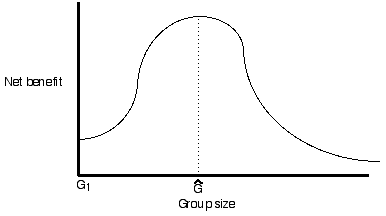
| Dept of Biology, Lewis and Clark College | Dr Kenneth Clifton
|
|
Biology
352 Lecture Outline
|
Animal dispersion continued: determinants of group size and territorial behavior
Often, as groups get larger, the costs of grouping (especially competition for resources) will begin to outweigh benefits of grouping, so, if grouping is favored, we expect a "hump-shaped" payoff curve

Given that such curves predict an Optimal Group Size, we can then ask: what groups do we expect to see in Nature?
Obviously, if the population size is small, groups may be smaller than predicted.When population size is larger than the optimum, groups of optimal size are possible.
However, under these circumstances we must consider not just the animals inside the group, but also the animals outside
In many cases, animals outside a group of "optimum size" will receive greater benefits by joining the group rather than being on their own (G1 on the graph). Unless current group members are able to exclude additional individuals (via group territorial behavior) then groups will be larger than the predicted optimum.
At an extreme, group size may grow until the benefits of group living equal those from solitary existence. This sets a theoretical maximum on group size (Gmax)
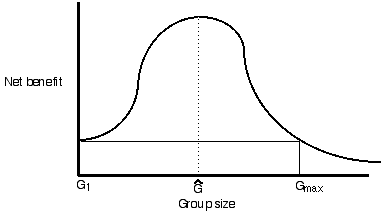
This may explain why many groups appear to be of larger than predicted size.
Thus, rather than "optimal group size" it may be more appropriate to consider "stable group size" when considering the sizes of groups found in nature.
Social rank may also influence whether an individual stays with or leaves a group:
With differences in social rank consider two questions:Why should dominant individuals tolerate the presence of subordinate individuals?Why should subordinate accept low rank within a group rather than going elsewhere?
To evaluate these ideas, you need data on the costs and benefits of group living for groups of various size, as well as information on solitary individuals (or some other, alternative form of group living). These are not easy data to collect in most cases.
Relatedness among group members may also influence the relative costs and benefits a specific individual receives from being part of a group. This may also lead to larger than predicted group sizes.
Now consider the opposite of grouping.... Spreading out via territorial behavior
Territoriality is an expression of dominance with spatial consequences.
Territorial behavior reduces the probability that other animals will occur within the defended area.This increases space between individuals, and may lead to more uniform patterns of distribution within a habitat.Territorial behavior entails costs (of defending) and benefits (from defended resources).
We can understand the adaptiveness of territorial behavior by examining these costs and benefits from an economic view point.The principle of economic defensibility: Territorial behavior should be favored when the costs of defending an area are outweighed by the benefits accruing from enhanced access to defended resources.
Corollary: Territories tend to be "worth more" to residents rather than intruders because of previous investment and because of better knowledge of territorial resources. Thus, all else being equal, territory owners tend to win contests against intruders
To analyze territory economics, examine the relationship of benefits and costs to territory size.
1) compute the benefit curve as a function of territory size2) compute the cost curve as a function of territory size
3) Identify the optimization criterion (B - C, minimize C, etc.) and compute optimal territory size. If 0 then territorial behavior is not favored
First consider the benefit curve: associated with resource levels, most likely an S-shaped function

Benefits increase with territory size to some maximum determined by resource levels
Many published models consider only a part of this curve
Next consider the cost curve: associated with defense costs
Defense costs are determined by two factors: size of area defended and intruder pressure.
1) Size of defended area:If intruders can appear anywhere within the territory, then the entire area must be monitored. Thus, costs, for a given intruder pressure, will be proportional to territory size SIf intruders enter territories at boundaries, then only the perimeter must be monitored. Thus, defense costs for a given intruder pressure will scale with S1/2.
2) Intruder pressure:
Pressure to invade comes either from:For fixed resource availability, higher animal density outside territoriesFor fixed animal densities, higher resource levels within territories.
The greater the difference between per capita resource availability inside and outside of territories, the greater the intruder pressure
If Ri is the resource density within a territory, S = territory size, N = territory group size, Ro = resource density outside the territory, and D = density of animals outside the territory then the intruder pressure on the territory per unit area will be proportional to:[(RiS/N) - (Ro/D)]
Costs of defense will be: kSj [(RiS/N) - (Ro/D)] where 1/2 ≤ j ≤ 1 depending on where residents must defend the territory.
Rewritten, this becomes: (kRi/N)Sj+1 - (kRo/D)Sj
Given the possible range for j, the exponent for S will always be > 1, thus the cost will plot as an accelerating function of S
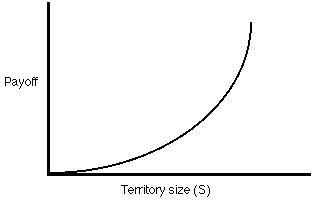
Economic Defensibility
By putting the benefit and cost curves onto the same plot and examining the region where B > C, we can see that territories are economically defensible for intermediate territory sizes (between S1 and S3)
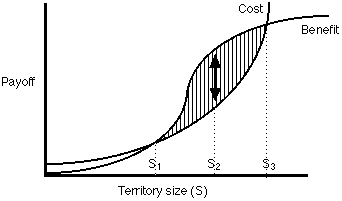
Animals trying to maximize their net payoff (B - C) should defend territories of size S2
As resource levels within an area drop, a territory will become less economically defensible, until there is no part of the curve where B > C. As resource levels increase, the optimal territory size of "rich" territories will be larger than "intermediate" territories (Si < Sr) assuming that costs do not scale with resource quality (probably an incorrect assumption for many territories).
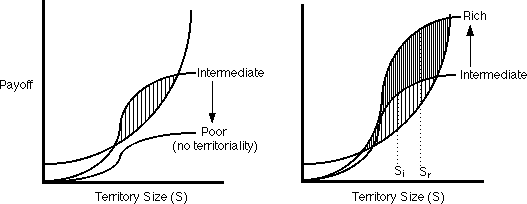
What does the model of intruder pressure suggest about defense costs as the resources within a territory become increasingly richer relative to outside the territory?